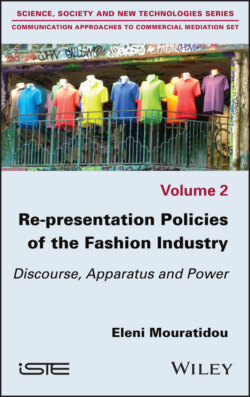Читать книгу Re-presentation Policies of the Fashion Industry - Eleni Mouratidou - Страница 6
Introduction
ОглавлениеOn October 9, 2005, the luxury ready-to-wear and leather goods brand Louis Vuitton celebrated the opening of its new flagship store1. For this occasion, contemporary artist Vanessa Beecroft designed an installation where lightly dressed young women posed on the boutique’s shelves and coexisted with the merchandise displayed in the same space. A few press articles consulted at the time cited the artist’s desire to sublimate “the violence of the brands that women usually suffer”2:
[a] mercantilist ambiguity: [...] under the impassive eye of the boss, Bernard Arnault, twenty frozen models dressed in thongs, their legs surrounded by a thin strip of leather, placed between two briefcases, their heads on a purse, composing a strange and disturbing living picture. A majority of them had brown skin, the others pale. The exact reproduction of the brand’s color code.3 (Author’s translation)
The mise en abyme of the commercial spectacle proposed by this installation posed at the same time, in my opinion, the question of the symbolic occupation of a non-commercial space,4 in this case artistic, by an exclusively commercial authority. Accused of violence – admittedly symbolic – fashion, its brands, its advertisers proceeded to recuperate, even divert (Debord and Wolman 1956, reprinted in Debord 2006, pp. 221–229), the said accusation by transforming it into a spectacle within their commercial space.
A few years later, in 2010, another merchandising scheme proposed by the fashion industry caught my attention. The Website of the ready-to-wear brand Zara published the making of its advertising campaign, while the same year5, the title Vogue Paris offered its subscribers DVDs qualified as bonus gifts presenting behind-the-scenes photo shoots organized by the magazine as part of its fashion and beauty editorials. I noted tension between the promise of the “communication contract” (Charaudeau 1983) that the “making of” format is supposed to carry and what the audiovisual content produced by Zara and Vogue Paris staged. From the object likely to show the conditions of conception, enunciation and production of a film, the “making of” of its two fashion actors – the advertiser and media authority – was transformed into a new advertising discourse. Proposed as an object that made the invisible visible, the “making of” and its derivatives, such as backstage, or behind the scenes only intensified the spectacle deployed by this industry (Mouratidou 2010, pp. 105–124).
Four years later, the French haute couture and luxury ready-to-wear brand Chanel unveiled its spring-summer 2015 collection at the Grand Palais, in the form of a street event6. The staging of this communication event was presented as “we can match the machos”7 and suggested “the wind of freedom” that blew in May 1968 in France was here again8. Between 2006 and 2011, another brand in the luxury industry, Yves Saint Laurent,9 offered its advertising campaign in the form of a leaflet distributed in the streets of major cities, including Paris. As for the examples previously cited, the strategy mentioned here was a generic hybridization and a confused staging where the limits between the communication and marketing policy and the artistic (Louis Vuitton and Vanessa Beecroft), film-based (making of, backstage) or, in the case of the last two examples, political claim and citizen movement seemed opaque. I noticed then that the fashion industry’s commercial strategies were supported and sometimes even appropriated forms resulting from citizen mobilizations or leaflet discourses (Angenot 1995) which, originally, were not developed to accompany and optimize commercial strategies and mediations.
In 1999, the Dior brand launched one of its most emblematic products. It was the perfume J’adore, a product with an undeniable commercial success10 and whose name contributes to the brand’s communication and symbolic positioning. While the advertising campaign designed for this product has always introduced Christian intertexts11, the product name, having gradually become a brand signature, further deployed a sacred dimension that would be unique to Dior: “J’adore Dior” had become a recurring statement in many of the brand’s communication strategies and, as a result, the statement implied the worship dimension that Dior was acquiring. As for the formula (Krieg-Planque 2009) “J’adore Dior”, in 2016 it underwent a syntactic transformation and gave rise to a portmanteau word that can be described as a neologism: j’adior, a contraction of J’adore and Dior. Since that year, this example of linguistic creativity, as well as communication and marketing creativity, has been applied to the brand’s products: shoes, T-shirts and caps. The sacralization of the fashion brand was once again presented as a long-term strategy to shift the commercial dimension of the company in question.
Finally, the Italian brand Miu Miu, a member of the Prada group, which also specializes in luxury ready-to-wear fashion, designed advertising campaigns in 2015 that took the form of documentary photography: the photographs pretended to escape a consciously organized staging while seeking to enhance a ready-to-wear collection; the models seemed to have been captured on the spot and the whole of this iconic statement was qualified through the explicit thematization of an event not associated with fashion and its products. Beyaert-Geslin (2009, p. 51) defines documentary photography as “the image produced by the practice of journalism. This practice can be called photojournalism (American version), which associates it with a given context, era and cultural sphere” (author’s translation).
It seems important to add that its purpose is not the promotion of a commercial instance and a commercial good, but the capitalization, the capture of an event. In the case of the Italian brand’s advertising campaigns, there was a difference between their medium (the magazine press, the national and/or regional daily press, poster spaces) and their genre12.
